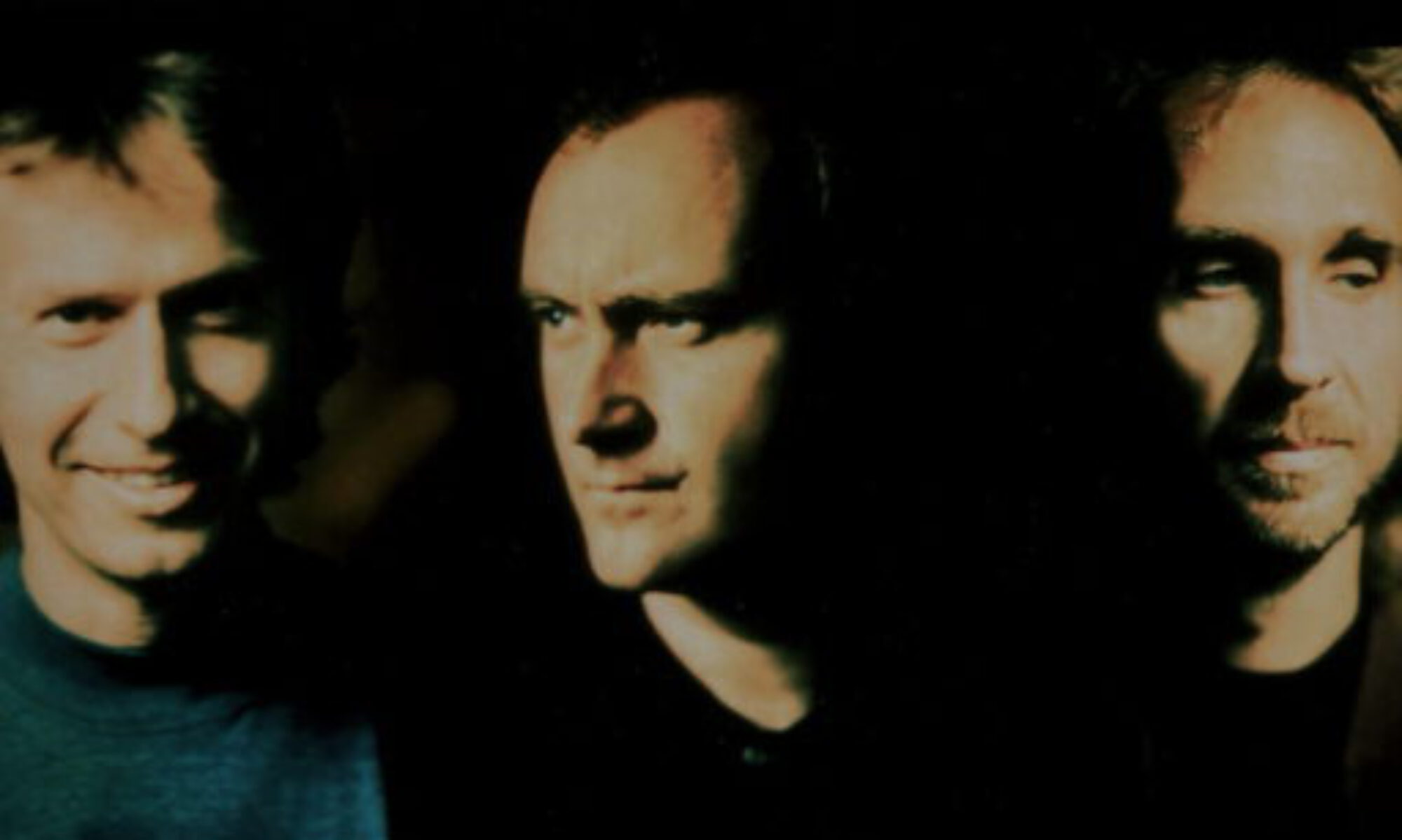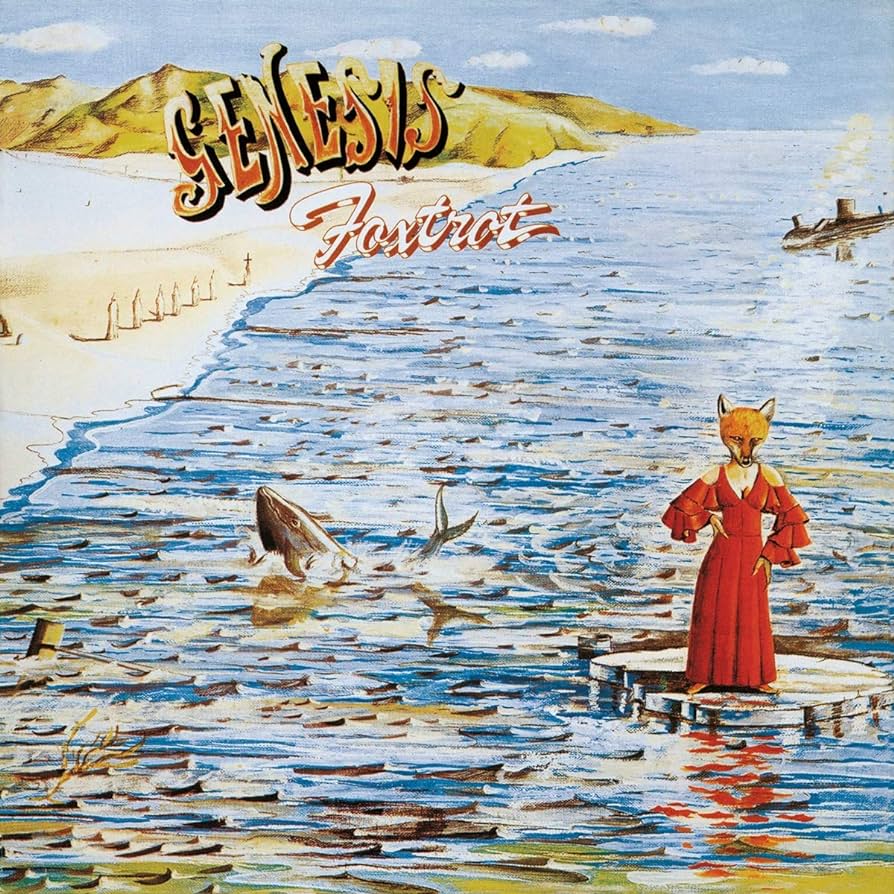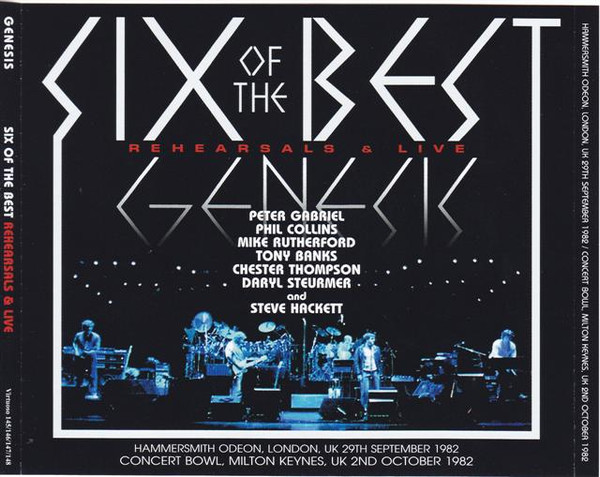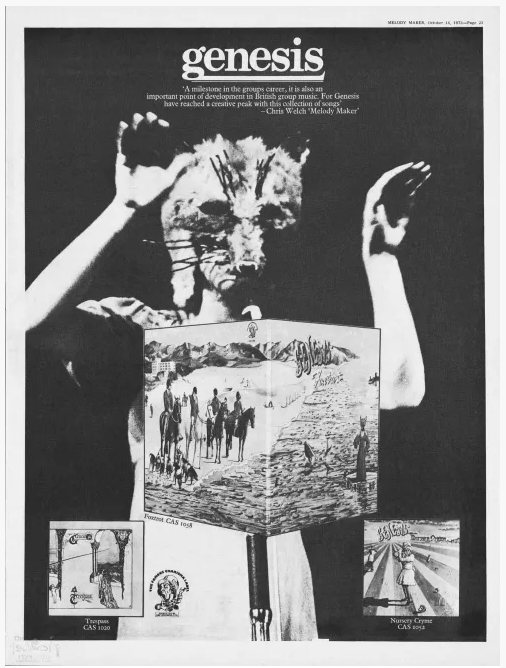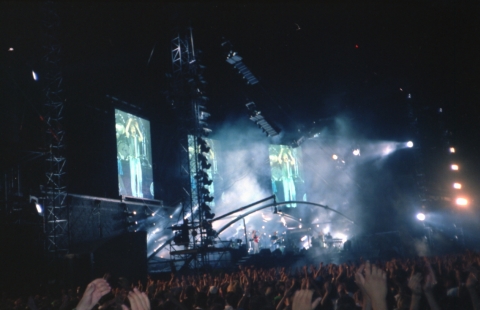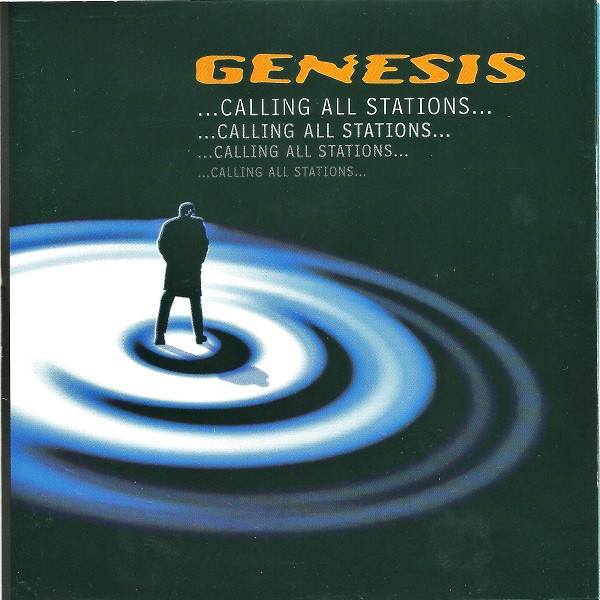Genesis’s second album, Trespass, marked a turning point in their musical journey. Released in October 1970 on the Charisma label (and on ABC Records in the US), the album showcased a band finding its identity, blending folk, rock, and soul in ways that set them apart from their contemporaries. Recorded at Trident Studios in London under the guidance of producer John Anthony, Trespass was a bold step forward for Genesis, a band on the brink of discovering their iconic sound.
Continue reading “Trespass (1970) – Genesis”Foxtrot (1972) – Genesis
It’s the year 1972. Genesis had released Nursery Cryme the year before and had played their first show overseas in Brussels in early 1972. Several shows in Europe followed and after their return to the UK, they began writing their next album Foxtrot, which, for many fans, would become their ‘progressive’ high point.
Continue reading “Foxtrot (1972) – Genesis”Invisible Touch (1986) – Genesis
Phil Collins: ‘The mid-1980s was the biggest we ever got.’1
In the mid-1980s, the gap between Genesis albums had become bigger. Phil Collins had started his solo career at the beginning of the decade and after the Genesis album Mike Rutherford had formed his chart-topping band ‘Mike and the Mechanics’ together with vocalists Paul Carrack and Paul Young. Tony Banks, having published solo albums since 1979, was the only one of the trio to not have significant chart success.
In 1985, Genesis went into their ‘Farm’ studio, again with producer Hugh Padgham, to write and produce their next album. The result was the powerful, vibrant album Invisible Touch, released in 1986. Out of the eight tracks, five became hit singles: ‘Tonight, Tonight, Tonight’, ‘Land of Confusion’, ‘In Too Deep’, ‘Throwing It All Away’ and the title track ‘Invisible Touch.’
Invisible Touch
The lead single ‘Invisible Touch’ is often ‘regarded by the loyal progressive-rock aficionado as a betrayal‘, as it represents Genesis ‘at its most commercial.’2 The song was, just like all the songs on the album, a product of group jamming. Paul Gomersall, the engineer who assisted Hugh Padgham on Invisible Touch remembered the band’s way of writing songs:
‘Mike would come up with some sort of wacky drum loop. He’d bring his drum machine in, or Phil would, and they’d work around that. Mike is very experimental. I think he sees himself as more like a Brian Eno sort of person who makes interesting sounds and rhythms. Tony’s stuff was more chordal. Half the sound of Genesis is the chords that Tony comes up with.’3
The song ‘Invisible Touch’ was written during such a jam session when Mike Rutherford played the guitar riff that became the basis of the song with an echo effect and Phil Collins started singing ‘She seems to have an invisible touch, yeah!’ Phil then wrote the lyrics about loving a mysterious person who gets under one’s skin, dominates one’s life and although it might be bad, one cannot keep away from them.
Like the rest of the album, the song ‘Invisible Touch’ is dominated by e-drum sounds used in 1980s pop music. The drum machine in the background was inspired by Sheila E.’s and Prince’s ‘The Glamorous Life’, released in 1985. These ingredients, along with Mike Rutherford’s bass line, Tony Banks’ keyboard solo and the key change in the outro, turn ‘Invisible Touch’ into a very energetic, joyous pop song.
Phil Collins: ‘Invisible Touch is my favourite Genesis song.’4
In concert, the band never performed ‘Invisible Touch’ in its original key, but down a half-step or more to save strain on Phil Collins’s voice. Still, he would turn it into a celebrated sing-a-long with the audience.
Mike Rutherford also mentioned that ‘Invisible Touch’ was one of his favourites to play live, as ‘it’s a wonderful song: upbeat, fun to play, always a strong moment in any gig.’5
For many ‘old-school fans’, the album Invisible Touch was a total sell-out and the song itself became a target of hate. It was their first and only number one hit in the US single charts and was even mentioned in American Psycho when lead character Patrick Bateman names it as the group’s ‘undisputed masterpiece.’
Tonight, Tonight, Tonight
‘Tonight, Tonight, Tonight’ is according to music journalist Chris Welch the band’s ‘most memorable pop ballad‘, with ‘a nagging electronic theme‘ and lyrics that ‘are alternately obscure and direct.‘6
The album version is 9-minutes long and includes various elements from the band’s career. Again, the song was a result of jamming (the working title being ‘Monkey/Zulu’) and one can hear how Tony Banks took the lead and improvised the long passages, including a middle section with ‘a series of suitably weird instrumental effects.’7 The abstract, but very direct lyrics by Phil, some of which were improvised too, are about drug abuse.
Mike Rutherford: ‘It’s more of the old-style Genesis in that it covers a lot of ground musically and has a fairly involved instrumental passage in the middle. We’ve done songs like this from the word go. The initial bit came from an improvised jam and the song and solo part in the middle were obvious from a longer section when Tony was just improvising sound over a rhythm being played by Phil and I and he just assembled a composed solo part.‘8
Mike Rutherford about Tony Banks: ‘He’s the most adventurous in terms of song format, he’s always trying to not get stuck into a verse, chorus, middle eight, he’ll always push us a little bit to question whether we couldn’t explore a bit more.‘9
Land of Confusion
Mike Rutherford wrote the lyrics for this rare politically themed song about the tension between nations, calling it ‘a political song about the mess we landed in. I’ve always shielded away from doing what I call a preachy song, a protest song, but it seemed to work. Maybe because the music was quite angry it made it work.’10
The music was written by all three members together.
Spitting Image and the music video
‘Land of Confusion’ became very famous for its promotional video, which not only showed Rutherford, Collins and Banks as puppets created by the British television comedy ‘Spitting Image’, but also politicians such as Jimmy Carter, Henry Kissinger, Leonid Brezhnev, Margaret Thatcher and of course Ronald Reagan, in whose nightmare all these caricatures appear.
The idea for the music video came as Genesis video director Jim Yukich saw Phil Collins being caricatured on the TV show ‘Spitting Image’, ‘a series of satirical programmes […] since 1984, in which lifelike but grotesque puppets act out scenes relating to topical events and people in the news, including especially politicians and members of the royal family‘.11
On the show, Phil’s puppet was performing a parody of his chart-topping love ballads, ‘Oh, You Must Be Leaving’ while weeping constantly.
The main protagonist in ‘Land of Confusion’ is Ronald Reagan, then president of the United States, who is in bed with his wife and a monkey. The monkey is a reference to the movie Bedtime for Bonzo, in which Reagan shared a bed with a monkey.
The video also features puppets of famous musicians Bob Dylan, David Bowie, Tina Turner, Michael Jackson and other celebrities. The music video won Genesis their first and only Grammy Award in 1987 for ‘Best Concept Music Video’.
Tony Banks: ‘What other video can boast having all these stars, like Madonna and Prince?’12
In Too Deep
In 1985, Phil Collins had been commissioned by Ray Cooper of Handmade Films (George Harrisons’ film company that he had set up to produce Monty Python) to write a song for the film Mona Lisa, starring Bob Hoskins and Cathy Tyson.
While on solo tour in Australia, he wrote the chorus of what became ‘In Too Deep’, but when the film was due to be released, Phil did not work on a solo album, but on a Genesis album. The three wrote the rest of the song and created a warm pop ballad, in which Phil shines on vocals while Tony is playing piano and Mike’s adds well-placed and delicate guitar accents. Submitting it to Ray Cooper, he naturally liked it very much, and inevitably ‘In Too Deep’ became a hit outside of the movie as well.
Tony Banks remembered not knowing what to do in the music video, which just shows the band playing because it was no funny song. Perhaps they should have included clips of Mona Lisa in between.
Anything She Does
This very fast song is dominated by Tony Banks’ synthesizers and the brass sounds with which he emulates horns, and Phil’s drums. The ending is deliberately chaotic.
With Tony Banks’ lyrics being about page three-girls, Genesis wanted to have British comedian Benny Hill as his character Fred Scuttle for the music video. Phil got the task of ringing him up. At this time, Hill wanted to get away from his image as ‘dirty old man’. The script saw the band rehearsing backstage at Wembley Stadium and him being the door man on duty while all the women lined up to try and get past him. Hill agreed on the condition that his character tried to chase the girls, but never got one. Phil was very happy for the signed photograph he got in the end.
Domino
Domino’ is a 11-minute epic in two parts (I. ‘In the Glow of the Night’, II. ‘The Last Domino’), which are very different from each other. Part One begins slowly and pretty until an abrupt ending and a musical explosion lead to Part Two in double tempo with a heavy beat.
Being the album’s long song, the lyrics about the desperation and loneliness in war time were written by Tony Banks.
Mike Rutherford: ‘His words are the reason why he’ll never write a hit single.’13
Phil Collins: ‘We were always a group of songwriters who would write 3-, 10- and 20-minute songs. We still write 10-minute songs, like ‘Domino’, but unfortunately, the three-minute songs have gotten better and become hits. I don’t feel we’ve bastardized the way we were, as we still work the same way. Diehard fans will say, ‘Rubbish. ‘The Carpet Crawlers, ‘I Know What I Like’ – that was progressive!’ But I don’t see that. We’d have killed for hit singles back in the early days!‘14
Mike drew a comparison to the costumes of Peter Gabriel: ‘Looking back, people forget the show’s an hour and three quarters maybe and the costumes were probably 15 minutes of the whole thing. When we started having hit singles with MTV and videos, a hit single overshadowed the whole album and people started sort of saying ‘You stopped doing long songs.’ We never did, really, every album had a sort of 15-minute-long song on it till the very end. But they were album tracks, so they weren’t on television, they weren’t on the radio, but live they were a big part of the set.’15
Throwing It All Away
‘Throwing It All Away’ is based on an intensive guitar riff by Mike that is repeated throughout the whole song. He also wrote the simple love-song lyrics.
The song gives Phil another opportunity to sing about the end of a relationship and again, he does what he can do best masterfully. Even though the topic is sad, the mood is very uplifting and the whole composition is a brilliant example of how concise the trio Banks/Collins/Rutherford could combine their songwriting skills. When played live, the song became famous for its call-and-response.
‘Throwing It All Away’ was live drummer Chester Thompson’s favourite song to play: ‘The crazy thing about that is that the full kit only comes in the last bit of the song, it’s mostly just hi-hat and bass drum and then you finally come in towards the end, but I just thought it was such a great feel, I loved playing that song.’16
The music video is made up of sequences filmed during the band’s 1986 tour, partly by Phil with a hand camera.
The Brazilian
The last song on Invisible Touch is the instrumental ‘The Brazilian’, which is full of strange electric percussion sounds and half-tone step and definitely is ‘the strangest and most demanding cut on the album’, as music journalist Chris Welch writes: ‘A re-affirmation of the band’s faith in its musical past, […] full of spacey sounds like a sea monster, breathing heavily and stomping up the beach.’17
Reception
Music journalist Chris Welch thinks that Invisible Touch comes closest to achieving the status of being Genesis ‘ultimate album’.18 Band biographers Bowler & Dray think that ‘certainly it was their best album since ‘Wind And Wuthering’‘ and ‘one of the very best albums of the 1980s.’19 . Some fan-reactions can be summed up nicely by Alan Hewitt, founder of Genesis’s official The Waiting Room fanzine, who described Invisible Touch as ‘the first Genesis album he ever played once and then turned into a frisbee‘.20
Tony Banks: ‘On ‘Invisible Touch’, you’ve got the ‘Domino’ suite, which is 12 minutes long, and ‘Tonight, Tonight, Tonight’, which is about nine minutes. Both are identifiably Genesis, the sort of thing that no one else does. If you add, say ‘The Brazilian’, which again is like no other group, you’ve got at least 50% of the album. There are songs like ‘Invisible Touch’ and ‘Throwing It All Away’, but we’ve always done those. It’s just that we do them better now. With the songs, say off ‘The Lamb Lies Down’, maybe they’re lyrically more complex, but in terms of the songs themselves – ‘Carpet Crawlers’ or ‘Counting Out Time’ – they’re all attempts at the same kind of things. Even ‘From Genesis to Revelation’ was all short songs, all attempts at writing hit singles. And all failed.‘21
The multi-platinum album Invisible Touch was the band’s most successful and granted by the critics. Songs like ‘Invisible Touch’, ‘Land of Confusion’ and ‘Tonight, Tonight, Tonight’ dominated international charts throughout 1986/87. In the US, charts were also calculated on radio airplay, so even the song ‘Anything She Does’, which had not been released as a single, ended up in the charts. Also, the song’s music videos were running endlessly on MTV, the new medium of music television that had come up in the 1980s.
Tony Banks: ‘It’s great having hits. I was brought up in the era of hits, in the 60s the next Beatles song coming out was the sort of high point of my existence.’22
Peter Gabriel had been equally successful at that time: The single ‘Invisible Touch’ had been knocked off no. 1 by his hit ‘Sledgehammer’ and his album So was equally successful and became his biggest-selling album. 1986 seemed to have been a good year for this former ‘art rock’ band and its members.
The Invisible Touch Tour
Mike Rutherford: ‘A lot of people came to see us in the 80s and 90s in America because of the hit singles, but I always knew the long songs would grab them. They were songs that were visually were impressive with the vari-lites. Those who came to see us because of the singles and the radio tracks went away with a different impression of us.‘23
The successful album was followed by a massive tour that led the band through ‘large open air arenas and stadiums in Europe and the USA. The tour also took in several shows in Japan, only their second visit to that country, and finally included their first ever shows in New Zealand and Australia.’ The tour culminated ‘in a record-breaking four consecutive nights at London’s enormous Wembley Stadium in 1987.’24
Phil Collins:‘The Wembley shows were very special. It was still the old Wembley; it was football territory. Everything just seemed to peak at that point. I’ve been thinking about the set of the time with ‘Home By The Sea’, where the lights were coming down.’25
The record-breaking Wembley shows were filmed for a home video release, the first using Sony Hi Definition film.
After the end of the 1987 tour, Phil, Mike and Tony went back to their solo careers. Genesis came together in 1991 to record and release their final studio album with Phil Collins, We Can’t Dance. But that’s another story.
Sources
Banks, Tony; Collins, Phil; Gabriel, Peter; Hackett, Steve; Rutherford, Mike; Dodd, Philip (2007): Genesis. Chapter & verse. New York: Thomas Dunne Books/St. Martin’s Griffin.
Barnett, Laura, ‘Phil Collins and Mike Rutherford: How we made Invisible Touch’, The Guardian (14 October 2014).
Bowler, Dave; Dray, Bryan (1992): Genesis. A biography. London: Sidgwick & Jackson.
CHESTER THOMPSON FULL INTERVIEW : HOW HE WENT FROM ZAPPA TO DRUMMING WITH GENESIS & PHIL COLLINS.
Genesis – Behind The Track (Land Of Confusion).
Hewitt, Alan, Opening the Musical Box – A Genesis Chronicle. (Firefly Publishing, 2000).
Holm-Hudson, Kevin (2008): Genesis and the lamb lies down on Broadway. Aldershot, England, Burlington, VT: Ashgate.
MIKE RUTHERFORD UNFILTERED: GENESIS GUITARIST/COMPOSER IN CONVERSATION.
PHIL COLLINS: HOW I GOT THE GENESIS AUDIENCES LAUGHING.
Platts, Robin (2007): Genesis. Behind the lines, 1967-2007. Burlington, Ont., Canada: Collectors Guide Pub.
Room, Adrian (1990): An A to Z of British life. Oxford: Oxford University Press.
Rutherford, Mike, The Living Years: The First Genesis Memoir. (Macmillan, 2014).
Thompson, Dave (2005): Turn it on again. Peter Gabriel, Phil Collins & Genesis. San Francisco: Backbeat Books.
‘Tony Banks Interview from ‘Genesis Songbook DVD’.
TONY BANKS UNFILTERED: GENESIS KEYBOARD PLAYER & COMPOSER IN CONVERSATION . FULL.. 1 Hour 53 Mins.
Welch, Chris (2005): Genesis. The complete guide to their music. London: Omnibus Press.
- Collins 2007: 263. ↩︎
- Holm-Hudson 2008: 133 ↩︎
- in Platts 2007: 133. ↩︎
- Barnett, Laura, ‘Phil Collins and Mike Rutherford: How we made Invisible Touch’, The Guardian (14 October 2014). ↩︎
- Barnett, Laura, ‘Phil Collins and Mike Rutherford: How we made Invisible Touch’, The Guardian (14 October 2014). ↩︎
- Welch 2005: 68. ↩︎
- Ibid. ↩︎
- Bowler & Dray 1992: 202. ↩︎
- Ibid. ↩︎
- Genesis – Behind The Track (Land Of Confusion). ↩︎
- Room 1990: 355. ↩︎
- Tony Banks Interview from ‘Genesis Songbook DVD. ↩︎
- Rutherford 2014: p. 150. ↩︎
- Thompson 2005: 224. ↩︎
- MIKE RUTHERFORD UNFILTERED: GENESIS GUITARIST/COMPOSER IN CONVERSATION. ↩︎
- CHESTER THOMPSON FULL INTERVIEW : HOW HE WENT FROM ZAPPA TO DRUMMING WITH GENESIS & PHIL COLLINS. ↩︎
- Welch 2005: 70. ↩︎
- Welch 2005: 68. ↩︎
- Bowler & Dray 1992: 201; 205. ↩︎
- Thompson 2005: 225. ↩︎
- Platts 2007: 134. ↩︎
- TONY BANKS UNFILTERED: GENESIS KEYBOARD PLAYER & COMPOSER IN CONVERSATION . FULL.. 1 Hour 53 Mins. ↩︎
- MIKE RUTHERFORD UNFILTERED: GENESIS GUITARIST/COMPOSER IN CONVERSATION. ↩︎
- Hewitt 2000: 60 ↩︎
- PHIL COLLINS: HOW I GOT THE GENESIS AUDIENCES LAUGHING. ↩︎
Anthony Phillips’s last gig with Genesis
On 18 July 1970, Genesis played their last show with founding member and guitarist Anthony Phillips at Haywards Heath.
Charterhouse and ‘The Anon’
Anthony Phillips joined Charterhouse, a public school in Godalming, Surrey, in April 1965. Being a guitarist, he quickly formed a band there with his fellow pupils Richard MacPhail, Rivers Jobe, Rob Tyrell and Mike Rutherford. They named themselves Anon and played songs by The Rolling Stones1, The Beatles and several other pop groups of the era. They performed mostly at parties.
The first member to bring in an own song into Anon was Anthony Phillips: ‘Pennsylvania Flickhouse’. They booked an hour of studio time at Tony Pike’s studio in Putney, as Richard MacPhail remembers: ‘We piled all the gear in Ant’s mother’s Mercedes and got on a bus and I thought ‘An hour, on my God, what are we gonna do with a whole hour? Each song’s three minutes long, that means we’re gonna get about nine songs done.’ We just got one done and we had huge rails with Mr Pike because everything was of course too loud and he said ‘You’re gonna ruin my equipment!’, all that classic stuff that went on in those days in recording studios.’2
In December 1966, the group disbanded.
Anthony Phillips in Genesis
In 1967, Ant and his friend and fellow guitarist Mike Rutherford began writing music together. To record a demo, they asked another Charterhouse pupil, Tony Banks, if he could play organ on a song. Tony agreed under the condition that his mate Peter Gabriel could also come along and sing one of their songs. Both of them had also played in a band at Charterhouse, The Garden Wall. Ant and Mike agreed and soon, former Garden Wall drummer Chris Stewart joined the group.
The demo tape was given to producer Jonathan King, who signed them to his publishing company and they recorded some singles. King then named the group Genesis, and the group recorded their first studio album From Genesis to Revelation (1969). Like on the singles, King added strings arranged by Arthur Greenslade to the mix. To their frustration, the band only found out about the strings when listening to the finished version of From Genesis To Revelation with only Ant Phillips showing his anger by storming out of the studio.
By mid-1969, the boys’ parents wanted them to resume education. At Charterhouse, Ant began studying for further A levels to pursue a university degree. But Ant and Mike had been gripped by rock and roll and decided to become professional musicians. By the end of the summer of 1969, Peter and Tony joined them in their wish to become full-time musicians. They began writing music and touring the country from late 1969 to early 1970. ‘Yet, something was lacking‘, it is said in the press kit of Ant’s first solo album, ‘Phillips, perhaps because he was younger than the others found that life on the road was getting in the way of his writing.’3
The unhappiness and the stress began affecting Ant’s health and also he began suffering from stage fright: : ‘I was in Watford Tech, I remember playing the opening thing of ‘Let Us Now Make Love’ and I looked at the guitar and I thought ‘I haven’t got a clue what comes next’ and then I saw myself playing, but it was really scary.’4 Rich MacPhail remembers him playing a gig at Hackney where Ant was almost catatonic.5
Ant battled with the stage fright for three months thinking it was a passing phase and then fell ill with bronchial pneumonia: ‘Doctors were advising me to leave [the band]6‘, Ant says.
In June 1970, Genesis recorded their second album Trespass. Ant enjoyed working in the studio, but in July, they went straight back into band-life with little sleep, a lot of excitement and although Richard MacPhail tried his best to nourish his mates, pretty basic food. They were travelling and sleeping in their bread van or on floors: ‘We literally pitched up somewhere in the Midlands and we had nowhere to stay’, Ant recalls. ‘Too far to go back and some guy said: ‘Well, I know a guy with a bloody big house in Buxton’ and we stayed on the drafted floor of a bloody big house in Buxton.’7
Anthony Phillips leaves the band
Finally, Ant decided to leave Genesis. ‘I remember driving out with with Richard MacPhail who said ‘Can we have a word with you?”, Mike Rutherford remembers. ‘To the pitch at Richmond rugby ground after a soundcheck. Light was falling, it was a weird atmosphere and Ant said he wanted to leave. It was a huge shock to me.’8 Ant’s last show was at Haywards Heath on 18 July 1970.
Tony Banks says: ‘I thought it was the end of the group. He was vital to its formation and in many ways he was the strongest member. We felt that whatever was special about us was a combination of the four of us being together in the same room so I assumed that when he left, that was it.’9
Losing Ant ‘was the closest we came to busting up’, Mike Rutherford agrees. ‘For some reason we felt so close that if one left, we thought we couldn’t carry on. Of all the changes we’ve been through, surviving Ant leaving was the hardest.’10
The aftermath
After Ant’s departure, Genesis did not disband, but his influence remained. The acoustic beginning of the ‘The Musical Box’, the opening song of their next album Nursery Cryme, was based on an instrumental guitar piece by Mike and Ant called ‘F Sharp’.
Ant himself went into a hiatus. ‘I left Genesis in a cloud of dust’, he says. ‘I remember I was listening to Sibelius when I had one those strange revelations – that I was terribly limited.’11 He started studying various musical styles and in 1974, he began teaching music as a means to further explore the subject. In 1977 he said: ‘In the time since I left Genesis, I’ve studied classical guitar, piano, orchestration.’12 That same year he released his first solo album The Geese And The Ghost. Anthony Phillips is still active as a musician today.
Title photo: Cover of one of the various editions of From Genesis to Revelation
Footnotes
- To this day, Ant sends Christmas cards to Richard addressed to ‘Mick Phail’. ↩︎
- RICHARD MACPHAIL INTERVIEW Revised : GENESIS early years ↩︎
- “The Geese and The Ghost Press Kit“. Passport Records. 1977. pp. 2–3. ↩︎
- ANTHONY PHILLIPS UNFILTERED: GENESIS C0-FOUNDER IN CONVERSATION ↩︎
- RICHARD MACPHAIL INTERVIEW Revised : GENESIS early years. In fact, Anthony Phillips has not played live to this day. ↩︎
- Cherry Red Interview: Anthony Phillips Story – Part 1 – Interview by Mark Powell – 2014 ↩︎
- ANTHONY PHILLIPS UNFILTERED: GENESIS C0-FOUNDER IN CONVERSATION ↩︎
- MIKE RUTHERFORD UNFILTERED: GENESIS GUITARIST/COMPOSER IN CONVERSATION. Now Revised ↩︎
- Bowler, Dave; Dray, Bryan, Genesis. A biography. (London: Sidgwick & Jackson, 1992), p. 35. ↩︎
- Ibid. ↩︎
- Hedges, Dan, ‘It’s that candour moment…’, Sounds (26 March 1977). ↩︎
- Ibid. ↩︎
Six Of The Best
On October 2, 1982, the legendary ‘Six Of The Best’ reunion show with Peter Gabriel and Genesis took place at Milton Keynes.
Continue reading “Six Of The Best”Dublin, 28 Sept 1972: Peter Gabriel wears a fox head and a red dress
On 28 September 1972, Peter Gabriel appeared onstage during ‘The Musical Box’ with the foxes’ head and the red dress from the Foxtrot album cover.
Continue reading “Dublin, 28 Sept 1972: Peter Gabriel wears a fox head and a red dress”Phil Collins’ last gig with Genesis at Cowdray Ruins on 18 September 1993
On 18 September 1993, Genesis played their last gig with Phil Collins at Cowdray Ruins before he left the band.
Genesis in 1993
1993 was a quiet year for Genesis. In 1992, the group had been on their huge’We Can’t Dance tour‘ following their 1991 album We Can’t Dance*. 1993 saw them returning to their solo projects. Phil Collins’ marriage to his second wife Jill started to fall apart with the tabloid press publishing story over story about the family. Phil wrote and released his solo album Both Sides*, a very dark and angry and certainly his most personal album, which unfortunately did not go very well with the critics. In these turbulent times, Genesis only played one gig, when they resurfaced briefly for ‘a charity gig at Cowdray Ruins in aid of the King Edward VII hospice where they were joined by such rock alumni as Pink Floyd and the remaining members of Queen.’1
Queen performed a set of songs with Roger Taylor and Paul Young from Mike and the Mechanics on vocals. Then Genesis took the stage, but not with their regular live members Chester Thompson on drums and Daryl Stuermer on bass and guitar. Instead, Roger Taylor of Queen and Gary Wallis of Mike and the Mechanivs played drums for them and bass/guitar was played by Mike’s bandmate from Mike and the Mechanics, Tim Renwick, who also played with Pink Floyd.
Genesis’ reunion in the picturesque scenery among these famous headliners saw them playing ‘Turn It On Again’, ‘Hold On My Heart’, ‘I Can’t Dance’ and ‘Tonight Tonight Tonight’/’Invisible Touch’. According to some sources, they were also said to have played Phil Collins’s solo song ‘That’s Just The Way It Is’, but that is highly doubtable.
Next up was Pink Floyd who played some of their classic tracks from the 1970s, some also sung by Paul Young and with Mike on bass. Phil remembers: ‘The Floyd I’ve never loved apart from ‘Arnold Layne’. But we did this gig…I went to the sound check, and I was listening to the Floyd and a couple of the things they played I thought ‘I quite like that. There’s a couple of things in there that, you know. They show promise.”2
After Pink Floyd, Eric Clapton played a few songs (with Mike playing bass) and at the end, the ‘All Star Cowdray Ruins Band’, a band that featured everyone that had performed that night, played ‘Ain’t That Peculiar’, ‘Can I Get A Witness’ and ‘Gimme Some Loving’. YouTube videos and audio recordings of the show exist, but in a very low quality, which is a shame when considering this was Phil’s last gig with Genesis.
It was a successful, but ‘low-profile show’ and ‘few people would have ever believed that it was also Phil Collins’s final appearance with the band he’d now fronted for 18 unexpected years’3.
The show may have been one of the reasons for Phil to leave Genesis, as he remembers: ‘In the middle of my writing and making BOTH SIDES, Genesis did a concert with Queen. […] But I didn’t enjoy it … As I was singing these songs, it didn’t feel natural. Obviously, it was bad timing, going just like that from doing my most personal thing to a Genesis thing and back. But it definitely felt like ‘What am I doing here?’, like shoes that don’t fit anymore’.’4
Some time after this gig, Phil decided to leave Genesis, but his departure would not be announced until 1996. But that’s another story.
The line-up of the Cowdray Ruins band (according to the programme):
TONY BANKS: Genesis Keyboards
ERIC CLAPTON Guitar
PHIL COLLINS Genesis Vocals
JOHN DEACON Queen Bass
DAVID GILMOUR Pink Floyd Guitar
ADRIAN LEE Mike &. Mech Keyboards
NICK MASON Pink Floyd Drums
TIM RENWICK Mech./Floyd Bass/Guitar
MIKE RUTHERFORD Genesis Guitar/Bass
ROGER TAYLOR Queen Vocals/Drums
GARRY WALLIS Drums
RICHARD WRIGHT Pink Floyd Keyboards
PAUL YOUNG Mike &. Mech Vocals
Source: YouTube
Sources
Hewitt, Alan (2000): Opening The Musical Box. London: Firefly Publishing.
Platts, Robin (2007): Genesis. Behind the lines, 1967-2007. Burlington, Ont., Canada: Collectors Guide Pub.
Thompson, Dave (2005): Turn it on again. Peter Gabriel, Phil Collins & Genesis. San Francisco: Backbeat Books.
Title photo: Genesis in corcerto. Nizza – Luglio 1992 . Source: Wikimedia Commons, Valerio Ravaglia / CC BY (https://creativecommons.org/licenses/by/3.0).
* = affiliate links
Calling All Stations (1997) – Genesis
After Phil Collins’ departure from Genesis in 1996, the remaining two members Tony Banks and Mike Rutherford kept writing music and hired a new singer: Ray Wilson, born in 1968, known as lead vocalist of the band Stiltskin.
Continue reading “Calling All Stations (1997) – Genesis”How Phil Collins joined Genesis
In August 1970, Phil Collins joined Genesis as their drummer. This is the story of how he got the job with the band.
‘Looking for someone’
In the summer of 1970, Genesis had faced what is often described by them as the greatest loss in their career. Guitarist and founding member Anthony Phillips had left the band after they had recorded the album Trespass, partly because he suffered terribly of stage fright. With Ant gone, the remaining three members also decided to look for a new drummer. Up to that point, Genesis had already had three drummers. Searching for a new guitarist and a new drummer, the band anonymously placed ads in the famous music magazine Melody Maker: ‘TONY STRATTON SMITH [their then label manager, note of the author] is looking for 12-STRING GUITARIST who can also play lead; plus DRUMMER sensitive to acoustic music.’ One of these ads caught the eye of a young drummer from London: Phil Collins.
Phil Collins had previously played in the band Flaming Youth (they had been called ‘Hickory’ at first) and released one album with them. He had been unhappy because they were not successful and hardly played any gigs. Approaching a career as a professional drummer, he started looking for a new band he could join.
Auditioning for Genesis
Phil and his mate Ronnie Caryl, a guitarist, were both interested in auditioning with the band behind the ad. Having known their manager Tony Stratton-Smith from previous musical projects, Phil went to the Marquee Club, where he knew he would find ‘Strat’, as he was called, at the bar. He asked him if he could join this mysterious band, but Strat told him that the band was very adamant and insisted on auditioning new members. He also told him that the band behind the ad was Genesis. Phil knew their name from the gig announcements in the back pages of Melody Maker.
By this time, Genesis was a threesome: Tony Banks on keyboards, Peter Gabriel on vocals and Mike Rutherford on guitar and bass. ‘I rang up and I guess it was Peter Gabriel who I spoke to’, Phil recalls. ‘He said ‘Yes, uhm, come down to my parents’ house in Chobham.”
Peter Gabriel was impressed when Phil mentioned that he had played with George Harrison. Later he and the rest of the band found out that Phil had only played tambourine on a George Harrison session, but it helped him get the audition.
Then, on a hot summer’s day, Phil and Ronnie drove to Peter Gabriel’s family home, a country house near Woking with a swimming pool and farms surrounding it.
According to Phil, Mike Rutherford wore a dressing gown, looking like a crushed velvet smoking jacket à la Noel Coward, and slippers (Mike insists that he wore swimming trunks and a dressing gown because they were by the pool). Peter Gabriel seemed a little bit eccentric to Phil, and Tony did not say much but had the appearance and demeanour of a ‘tortured artist’, as Phil put it.
Phil and Ronnie had arrived early and there were still some drummers auditioning before him. He was invited to have swim in the pool while waiting.
‘Being there early and having two or three drummers ahead of me, I didn’t know what the conversation was, what they were saying to each other, but I could hear the music’, Phil remembers. ‘The same piece of music being played two or three times and the same piece of music being played with the next guy two or three times. So by the time I came up to play, I kind of felt I knew what I was doing.’
The band had given the drummers pieces from their repertoire that represented the various styles Genesis was playing at the time. It was a mixture of lighter passages, heavier passages and of course, very experimental passages. When it was Phil’s turn, they played him the album Trespass in the house’s living room. Phil felt that the music was very soft and immediately liked the harmonies (a feature in Genesis music that would disappear in their later works), which reminded him of Crosby, Stills & Nash. Phil later said that he would have joined them even if he had not liked the music because he was a professional drummer in search of work.
Having listened to the other drummers while swimming in the pool, he then played everything the band had prepared perfectly.
Peter Gabriel adds: ‘Just the way he sat down on the stool, I knew he was going to be good. Some people have this sort of confidence about what they do.’
When driving away, Ronnie said that he thought Phil failed the audition, but that he – Ronnie – had done a good job. As history proved, it was the other way round. Some time after the audition, Phil got the job and became a member of Genesis, while Ronnie did not. He had not been the right guitarist for their kind of music. Today, Ronnie Caryl actually still plays with Phil Collins in his solo band.
Impressions of Genesis
Having succesfully auditioned, the 19-year old Phil Collins joined Genesis in August 1970. At first, the band took a two-week holiday break and after that, they met to rehearse at Farnham Maltings, a place that Mike’s father had helped them to rent. There, they rehearsed for six weeks and wrote what was to become their album Nursery Cryme.
Purchase Nursery Cryme here on Amazon*
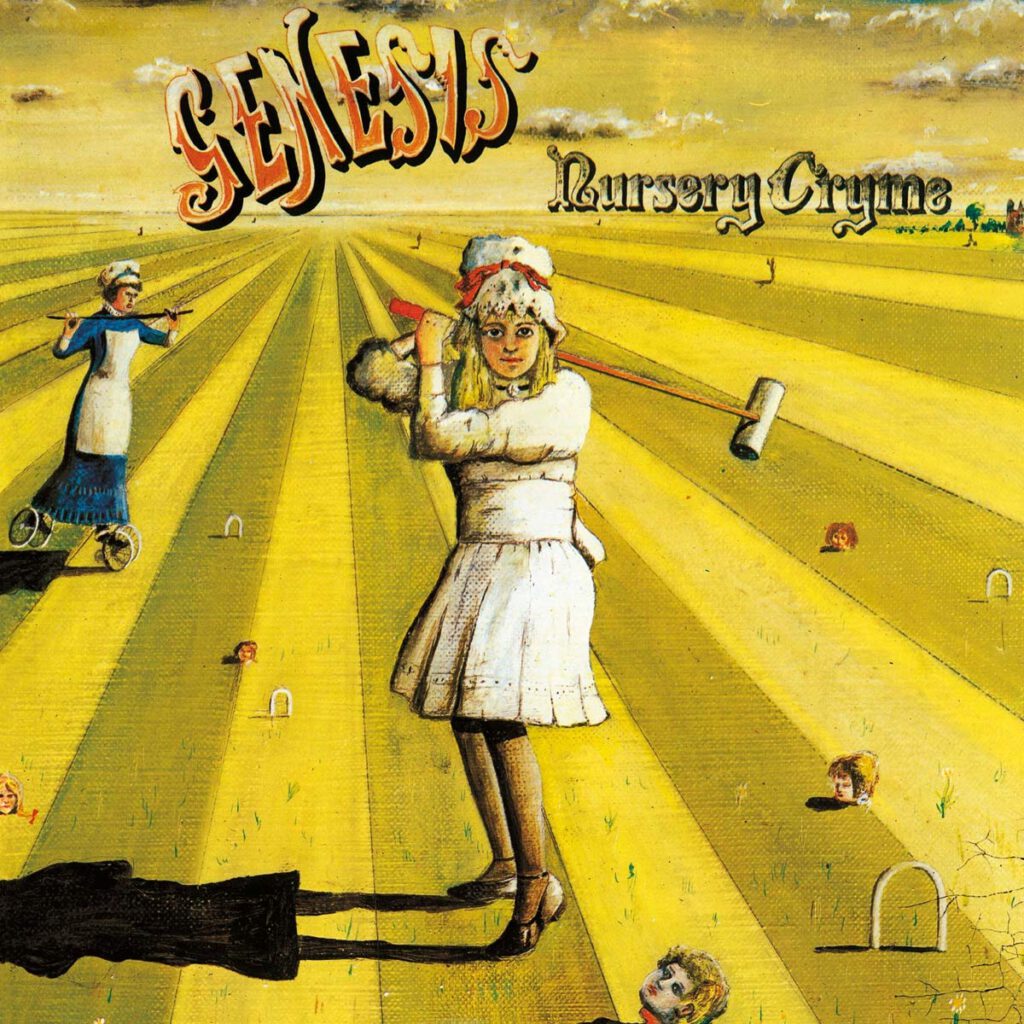
Coming from Grammar School and Stage School and being a working-class kid, Phil had a very different background than the ‘Charterhouse’-guys, who were upper-class public school boys. Phil realized they were very highly educated and very different to him; Tony Banks with his long hair reminded him of Beethoven. Also, he was irritated by Peter Gabriel’s bass drum that used to be right next to his microphone stand and that Peter just played whenever he felt like it, often completely out of rhythm.
At this point in their career, Genesis had released two albums and were preparing to write their third album. Very soon, Phil realized there was tension within the group. Especially Tony Banks and Peter Gabriel used to have arguments and – sometimes rather violent – disagreements.
‘In the middle of a conversation, suddenly someone would get up and slam a guitar on the floor and walk out’, Phil says. ‘I thought ‘What?’ Someone had said something to upset somebody else. Two hours later this person would come back and we’d start playing again. Suddenly there’d be ‘Oh, f*ck you’ and somebody else walked out. It was very highly strung.’
‘I would often be at loggerheads with Tony Banks’, Peter Gabriel explains, ‘and Phil would always sit on the fence, he would never want to come into the argument.’
Phil quickly realized that his different attitude and background not only had an influence on the music, but on the dynamics in the band too. ‘I saw it was my job to deflate these situations with humour, which the stage school background enabled me to do’, he says.
Genesis guitarist Mike Rutherford adds: ‘Apart from the humour, he’s got a very laid-back approach. He was very serious about his work, but had a very laid-back approach to life, which I think helped us a little bit.’ Mike also thinks that having auditioned at the Gabriel’s country house might have given Phil the impression that playing with Genesis would be a nice, relaxing job. In fact, they would spend their lives in the back of a van on the road for the next couple of years.
Title photo: Genesis – ‘The Knife’ (single cover).
Get “Genesis – BBC Broadcasts” here!*

Genesis Music on Amazon*
*= affiliate link
Sources
Phil Collins – A Life Less Ordinary (documentary, 2002)
Genesis – Sum of the Parts (documentary, 2014)
Philipp Röttgers – Two eras of Genesis? The development of a rock band (book, 2015)
The end of the Invisible Touch Tour at Wembley 1987
On July 4, 1987, Genesis finished their gigantic Invisible Touch tour at Wembley Stadium. It was the fourth sold out night in a row at Wembley.
Invisible Touch
In 1986, Genesis released the album Invisible Touch. It became their most successful album, peaking at #1 in the U.K. and #3 in the U.S. It produced five hit singles: ‘Invisible Touch’, ‘Tonight Tonight Tonight’, ‘Land of Confusion’, ‘In Too Deep’ and ‘Throwing It All Away’. Songs like the title track, ‘Tonight, Tonight, Tonight’ and ‘Land Of Confusion’ with its famous spitting image video would dominate the radio and music TV stations and the international charts of 1986/1987. Genesis were everywhere and bigger than ever. So of course, the band went on a massive tour through North America, Australia, Japan and Europe before finishing in Britain with four sold-out nights at Wembley Stadium in front of 300,000 people.
Purchase Invisible Touch here on Amazon!*
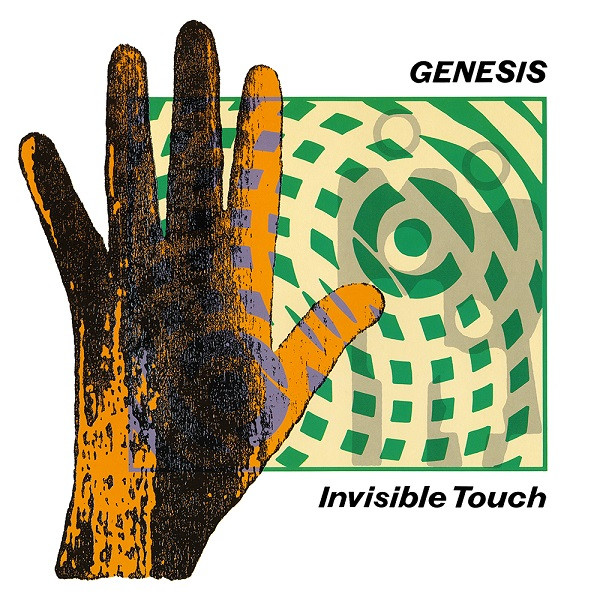
The Invisible Touch tour
The tour began in the U.S. in September 1986 and included 112 dates and sold close to two million tickets. It ended in July 1987. In Australia and New Zealand, the five-man line-up was accompanied by a four-piece string section on ‘In Too Deep’ and ‘Your Own Special Way’. They had to invite the quartet because of local regulations that required them to employ local musicians.
At this time, the band was not only a hit-machine, but a working and brilliant live act. The Vari Lite light show was impressive as always. The band had much material to rely on, but chose mainly new songs from their hit album and the albums before.
The shows were always opened with ‘Mama’ (which sometimes lacked a bit of atmosphere in daylight) and ended with the ‘Turn It On Again’ hit medley that the band had established on the previous tour. The medley included ‘Everybody Needs Somebody to Love’, ‘Satisfaction’, ‘Twist and Shout’, ‘Pinball Wizard’, ‘All Day and All of the Night’ and ‘Karma Chameleon’.
Older songs in the set included ‘Los Endos’, ‘Home By The Sea’ (including it’s meanwhile standard ghost-story introduction) and another ‘In The Cage’ medley. When the tour began, they had played ‘In That Quiet Earth’ and the second half of the epic ‘Supper’s Ready’ after ‘In The Cage’. However, during the tour Phil had difficulties reaching the higher notes in ‘Supper’s Ready’, so by the middle of the tour they had gone back to the usual ending of ‘In That Quiet Earth’ and ‘Afterglow’.
New songs included ‘Domino’ (with another – soon to be famous – introduction by Phil), ‘Tonight, Tonight, Tonight’, ‘Throwing It All Away’, where the call-and-response singing developed throughout the tour, and ‘Invisible Touch’ itself.
Live at Wembley Stadium
‘Nearly 300,000 people at Wembley. OK, there might have been a few repeats in there, but I thought at the time, and I still think now, that moment was the peak of our career’1 – Tony Banks.
By the time Genesis got to Wembley, they had performed the set so often that it had become a true piece of fine art and musicianship. Interestingly, only two shows were scheduled at Wembley, but the demand for tickets was so high, that a third and then a record-breaking fourth night were added. Genesis ended in Guinness World Records until Michael Jackson sold out Wembley Stadiums on seven nights on his Bad World Tour one year later.
The Wembley shows were filmed and released as video and as DVD in 2003. Unfortunately the famous ‘In The Cage’ medley was left out of the release because on every night, the tapes had to be changed during that song.
Apart from that, the results and the performance are astonishing. The band truly ended the tour on a high note there. Looking back at the videos and listening to the songs and performances, we can say that Genesis were at their peak at this very point at Wembley Stadium. Afterwards, the fans had to wait four more years for a new Genesis record.
Title photo: Genesis Nancy 1987. Phil Collins, Tony Banks, Mike Rutherford, Daryl Stuermer, Chester Thompson. Genesis en concert à Nancy le 14 juin 1987 au stade Marcel-Picot de Nancy-Tomblaine Source: Wikimedia Commons, Fredamas / CC-BY-SA-2.5 (https://creativecommons.org/licenses/by/3.0).
Listen to songs recorded at Wembley in 1987 on “Genesis – BBC Broadcasts” – Get it here!*

Genesis Music on Amazon*
Purchase Live at Wembley here on Amazon!*
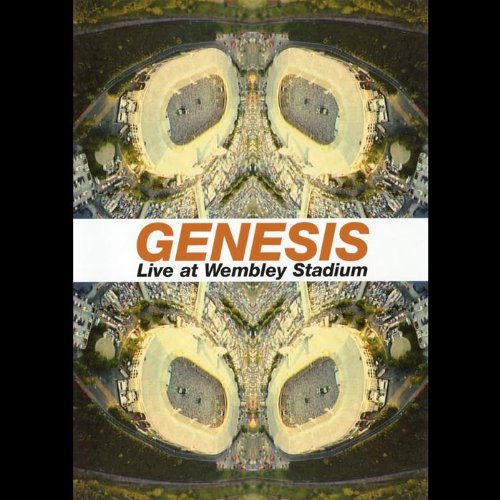
*= affiliate link
- in Banks, Tony; Collins, Phil; Gabriel, Peter; Hackett, Steve; Rutherford, Mike; Dodd, Philip, Genesis. Chapter & verse. (New York: Thomas Dunne Books/St. Martin’s Griffin, 2007), p. 287. ↩︎
